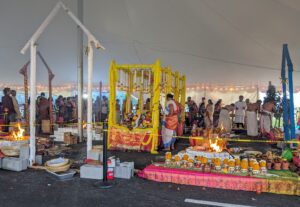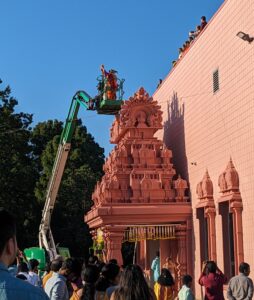
As the sun rises on this warm September morning, a crowd congregates inside the Hindu Temple of Kentucky. It’s the last day of MahaKumbhabishekam, a special week-long celebration at the temple, where attendees are adorned in ornate saris or achkans, traditional Indian clothing, a rainbow of bright colors and shimmering fabrics. The community bustles about organizing the festivities, which involve Hindu priests from neighboring states, as well as internationally renowned Hindu gurus.

MahaKumbhabishekam happens every 12 years to renovate and reconsecrate a Hindu temple. “Kumbha” means a water pot; “Abhishekam” is the ritual of pouring consecrated water over the Temple towers (Gopurams and Vimanam) to purify and energize them. During the process of renovating the Temple, the community decommissions the space – only Hindu priests are allowed inside as parts are restored. This morning, most of the ritual takes place outside the Temple under a large, white tent.
A Hindu priest chants continuously in reverent prayer as other priests enact ancient rituals to consecrate the pots of holy water. Small fires burn, illuminating elaborate arrangements of flowers and other organic offerings. Four door frames, each a different color, are connected by a thick wire that forms a floating boundary overhead. A delegate from the Temple, Dr. Johnny Alse, explains that the priests’ chants and rituals imbue the cord with energy that will permeate the Temple building. This energy is accessible to those who visit and pray at the Temple in the years to come.
Hinduism is an ancient tradition, regarded as the world’s oldest religion. Most modern-day Hindus live and practice in India, where the tradition emerged over 4,000 years ago. Today, over 1 billion people practice Hinduism, making it the third-largest world religion. The Hindu Temple of Kentucky was founded in 2000 and now serves around 1,500 families. The local community represents folks of Bhutanese, Nepalese, and Indian descent.
 Hinduism encompasses diverse spiritual ideologies, sacred texts, and traditions. There is no specific founder or single belief system. There are four main Hindu sects — Shaivism, Vaishnava, Shaktism and Smarta — along with myriad smaller sects. Some common Hindu ideas include the four Purusarthas, or aims of human life: dharma (ethics/duties), artha (prosperity/work), kama (desires/passions), and moksha (liberation/freedom from samsara, or the cycle of birth, death, and rebirth). Hindus worship many gods and goddesses in addition to Brahman, who is believed to be the supreme God force present in all things. Hindus can worship at home, as well as at the Mandir, or temple.
Hinduism encompasses diverse spiritual ideologies, sacred texts, and traditions. There is no specific founder or single belief system. There are four main Hindu sects — Shaivism, Vaishnava, Shaktism and Smarta — along with myriad smaller sects. Some common Hindu ideas include the four Purusarthas, or aims of human life: dharma (ethics/duties), artha (prosperity/work), kama (desires/passions), and moksha (liberation/freedom from samsara, or the cycle of birth, death, and rebirth). Hindus worship many gods and goddesses in addition to Brahman, who is believed to be the supreme God force present in all things. Hindus can worship at home, as well as at the Mandir, or temple.
Back at the Hindu Temple of Kentucky on this final day of MahaKumbhabishekam, priests transport pots of holy water to the building. Mechanical lifts raise the gurus and priests above the crowd so they can sanctify the Temple. They chant in prayer and pour water over the building; gurus throw flower petals in blessing. Family groups and friends take photos and selfies. Children play. Elders smile. The celebration will continue all day, into the evening, setting a sacred foundation for another 12 years.
To view captivating video footage of MahaKumbhabishekam, see the Hindu Temple’s Youtube channel.
Learn more about what’s happening at the Hindu Temple of Kentucky here.